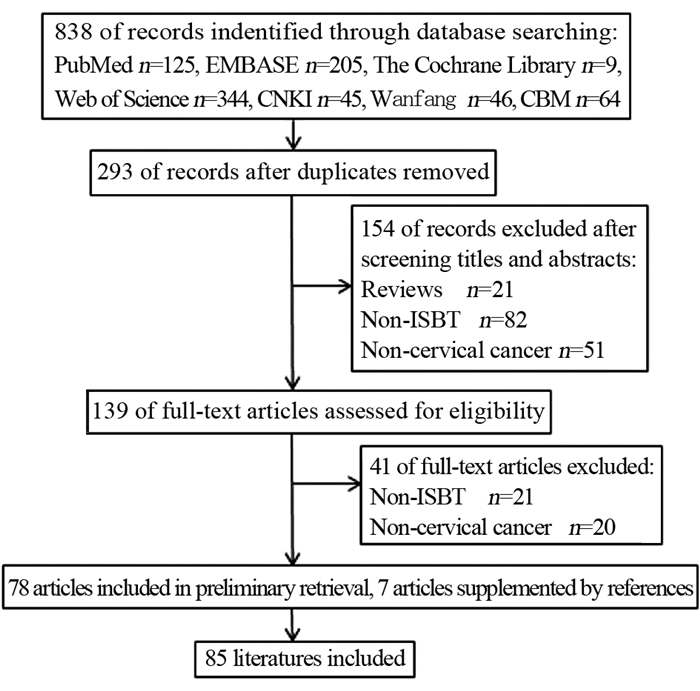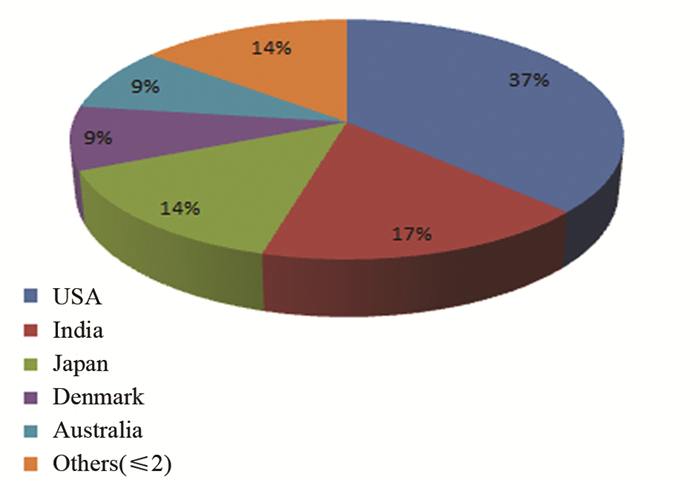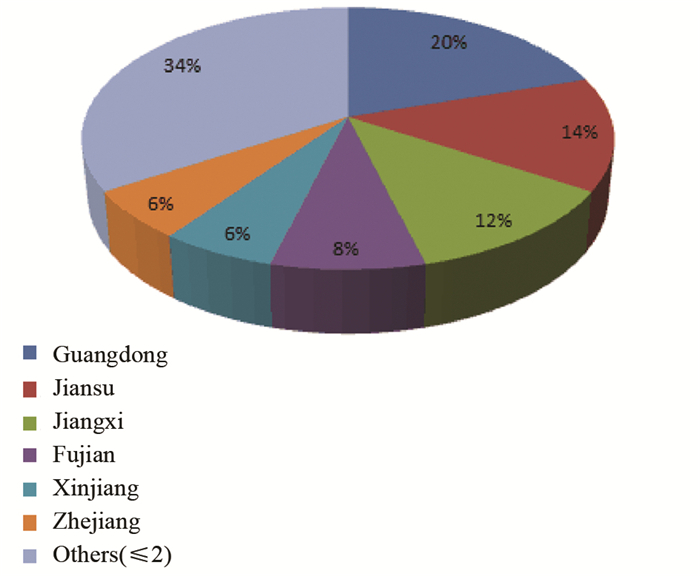-
摘要:目的
了解宫颈癌组织间插植放疗的研究现状,对比分析国内外不同插植模式的应用。
方法检索PubMed、EMBASE、Web of Science、Cochrane Library(2015年12期)、中国生物医学文献数据库(CBM)、中国知网(CNKI)和万方数据库,检索时间均为建库至2015年12月31日。全面收集有关宫颈癌组织间插植近距离放疗的临床研究,由两名评价员分别进行文献筛选,并按照预先设计的资料提取表进行资料提取。
结果共纳入85篇研究,英文35篇,中文50篇,其中24.7%(21/85)研究为临床对照研究。英文研究第一作者国家主要集中在美国(13/35)和印度(6/35),而中文研究主要分布于广州(10/50)和江苏(7/50)。中文文献来自43种期刊,仅18%(9/50)被中国科学引文数据库(CSCD)收录。随访时间、插植相关特征、治疗引导方式等报告率较低。大多研究(60/68)采用高剂量率(high dose rate, HDR)近距离治疗,采用的插植模式多达11种。32%(8/25)英文文献采用单次剂量5.5~6 Gy,每天两次,5~6次,均为会阴模板全麻下插植,而53.1%(17/32)的中文文献采用单次剂量8~12 Gy,每周1次,1~3次,均为徒手插植。
结论宫颈癌组织间插植放疗研究的临床特征报告率较低,尤其是中文文献,同时对照研究数量较少。中英文研究组织间插植模式多样,无论是插植剂量,还是插植模板、麻醉方式均存在明显的差异。
Abstract:ObjectiveTo analysis the status of interstitial brachytherapy(ISBT) treatment of cervical cancer and compare the application of different ISBT modes.
MethodsThe databases of PubMed, EMBASE, Web of Science, Cochrane Library(2015. Issue12), Chinese Biomedical Literature Database (CBM), China National Knowledge Infrastructure (CNKI) and Wanfang were searched from the starting to December 31st, 2015. The clinical studies on ISBT were comprehensively collected. Articles were screened by two reviewers and the process of extraction was done by pre-designed table including general characteristic and radiation-related clinical features.
ResultsA total of 85 studies were included, 35 in English and 50 in Chinese. 24.7%(21/85) were clinical controlled studies. The first authors in English studies were mainly from America (13/35) and India (6/35), while those in the Chinese articles were mainly from Guangzhou (10/50) and Jiangsu(7/50) of China. Chinese articles were from 43 journals and only 18.0%(9/50) were included by CSCD. The reporting of follow-up time, feature of ISBT and treatment guided methods was incomplete. Most studies (60/68) used high dose rate (HDR) brachytherapy, and 11 modes were applied. The mode of 5.5-6Gy per fraction and 5-6 fractions twice a day were used by transperineal ISBT in 32%(8/25) of English studies, but 53.1%(17/32) of Chinese studies used 6-12Gy per fraction and 1-3 fractions weekly by barehanded ISBT.
ConclusionThe reporting of ISBT on cervical cancer is still incomplete, especially in Chinese studies. The number of controlled trial is small. The modes of ISBT are various and non-standard. It has significant differences in ISBT dose, template and anesthesia.
-
Key words:
- Cervical cancer /
- Interstitial brachytherapy /
- Brachytherapy /
- Status analysis
-
-
表 1 纳入研究的一般特征
Table 1 Characteristics of included studies

表 2 纳入研究一般特征报告情况
Table 2 Reporting quality of characteristics of included studies

表 3 纳入研究的插植相关特征表
Table 3 Characteristics of ISBT in included studies

表 4 HDR-ISBT剂量模式总结表
Table 4 Summary of radiation dose pattern on HDR-ISBT

-
[1] 蓝建发, 潘华, 李瑞萍, 等.局部晚期宫颈癌辅助治疗的临床意义[J].兰州大学学报(医学版), 2015, 41(5): 33-8. http://www.cnki.com.cn/Article/CJFDTOTAL-LZYX201505007.htm Lan JF, Pan H, Li RP, et al. The clinical significance of adjuvant treatment of locally advanced cervical cancer[J]. Lanzhou Da Xue Xue Bao (Yi Xue Ban), 2015, 41(5): 33-8. http://www.cnki.com.cn/Article/CJFDTOTAL-LZYX201505007.htm
[1] 蓝建发, 潘华, 李瑞萍, 等. 局部晚期宫颈癌辅助治疗的临床意 义[J] 兰州大学学报(医学版), 2015, 41(5): 33-8. [Lan JF, Pan H, Li RP, et al. The clinical significance of adjuvant treatment of locally advanced cervical cancer[J]. Lanzhou Da Xue Xue Bao (Yi Xue Ban), 2015, 41(5): 33-8.] [2] 任锦霞, 王小虎, 赵林, 等. 紫杉醇+顺铂同步放、化治疗局部 中晚期宫颈癌的临床观察[J].兰州大学学报(医学版), 2009, 35 (2): 54-7. [Ren JX, Wang XH, Zhao L, et al. Clinical efficacy of concurrent chemo-radiotherapy using paclitaxel and cisplatin in the treatment of advanced cervical cancer[J]. Lanzhou Da Xue Xue Bao (Yi Xue Ban), 2009, 35 (2): 54-7.] [2] 任锦霞, 王小虎, 赵林, 等.紫杉醇+顺铂同步放、化治疗局部中晚期宫颈癌的临床观察[J].兰州大学学报(医学版), 2009, 35(2): 54-7. http://www.cnki.com.cn/Article/CJFDTOTAL-LZYX200902018.htm Ren JX, Wang XH, Zhao L, et al. Clinical efficacy of concurrent chemo-radiotherapy using paclitaxel and cisplatin in the treatment of advanced cervical cancer[J]. Lanzhou Da Xue Xue Bao (Yi Xue Ban), 2009, 35 (2): 54-7. http://www.cnki.com.cn/Article/CJFDTOTAL-LZYX200902018.htm
[3] Eifel PJ, Winter K, Morris M, et al. Pelvic irradiation with concurrent chemotherapy versus pelvic and para-aortic irradiation for high-risk cervical cancer: an update of radiation therapy oncology group trial (RTOG) 90-01[J]. J Clin Oncol, 2004, 22(5): 87 2-80. [3] Eifel PJ, Winter K, Morris M, et al. Pelvic irradiation with concurrent chemotherapy versus pelvic and para-aortic irradiation for high-risk cervical cancer: an update of radiation therapy oncology group trial (RTOG) 90-01[J]. J Clin Oncol, 2004, 22(5): 872-80. doi: 10.1200/JCO.2004.07.197
[4] Lindegaard JC, Tanderup K, Nielsen SK, et al. MRI-guided 3D optimization signi?cantly improves DVH parameters of pulseddose- rate brachytherapy in locally advanced cervical cancer[J]. Int J Radiat Oncol Biol Phys, 2008, 71(3): 756-64. [4] Lindegaard JC, Tanderup K, Nielsen SK, et al. MRI-guided 3D optimization significantly improves DVH parameters of pulsed-dose-rate brachytherapy in locally advanced cervical cancer[J]. Int J Radiat Oncol Biol Phys, 2008, 71(3): 756-64. doi: 10.1016/j.ijrobp.2007.10.032
[5] Sharma DN, Gandhi AK, Sharma S, et al. Interstitial brachytherapy vs. intensity-modulated radiation therapy for patients with cervical carcinoma not suitable for intracavitary radiation therapy[J]. Brachytherapy, 2013, 12(4): 311-6. [5] Sharma DN, Gandhi AK, Sharma S, et al. Interstitial brachytherapy vs. intensity-modulated radiation therapy for patients with cervical carcinoma not suitable for intracavitary radiation therapy[J]. Brachytherapy, 2013, 12(4): 311-6. doi: 10.1016/j.brachy.2012.10.003
[6] Nag S, Erickson B, Thomadsen B, et al. The American Brachytherapy Society recommendations for high-dose-rate brachytherapy for carcinoma of the cervix[J]. Int J Radiat Oncol Biol Phys, 2000, 48(1): 201-11. [6] Nag S, Erickson B, Thomadsen B, et al. The American Brachytherapy Society recommendations for high-dose-rate brachytherapy for carcinoma of the cervix[J]. Int J Radiat Oncol Biol Phys, 2000, 48(1): 201-11. doi: 10.1016/S0360-3016(00)00497-1
[7] 麦苗青, 陈佩芬, 冯桂荣. 宫颈癌大出血行宫颈插植后装放疗止 血的疗效观察及护理[J]. 护理实践与研究, 2015, 12(3): 77-8. [Mai MQ, Chen PF, Feng GR. Efficacy and nursing of hemostasis after interstitial brachytherapy for cervical cancer bleeding[J]. Hu Li Shi Jian Yu Yan Jiu, 2015, 12(3): 77-8.] [7] 麦苗青, 陈佩芬, 冯桂荣.宫颈癌大出血行宫颈插植后装放疗止血的疗效观察及护理[J].护理实践与研究, 2015, 12(3): 77-8. http://www.cnki.com.cn/Article/CJFDTOTAL-HLSJ201503042.htm Mai MQ, Chen PF, Feng GR. Efficacy and nursing of hemostasis after interstitial brachytherapy for cervical cancer bleeding[J]. Hu Li Shi Jian Yu Yan Jiu, 2015, 12(3): 77-8. http://www.cnki.com.cn/Article/CJFDTOTAL-HLSJ201503042.htm
[8] 李小文, 高冬梅, 阿依努尔•色义提. 宫颈癌CT引导的三维插植 腔内后装放疗中膀胱壁、直肠壁受照剂量的评价[J]. 新疆医 科大学学报, 2014, 37(10): 1329-33. [Li XW, Gao DM, Ayinuer SYT. Dose of bladder and rectal by CT-guided three dimensional interstitial brachytherapy radiation[J]. Xinjiang Yi Ke Xue Xue Bao, 2014, 37(10): 1329-33.] [8] 李小文, 高冬梅, 阿依努尔·色义提.宫颈癌CT引导的三维插植腔内后装放疗中膀胱壁、直肠壁受照剂量的评价[J].新疆医科大学学报, 2014, 37(10): 1329-33. http://www.cnki.com.cn/Article/CJFDTOTAL-XJYY201410024.htm Li XW, Gao DM, Ayinuer SYT. Dose of bladder and rectal by CT-guided three dimensional interstitial brachytherapy radiation[J]. Xinjiang Yi Ke Xue Xue Bao, 2014, 37(10): 1329-33. http://www.cnki.com.cn/Article/CJFDTOTAL-XJYY201410024.htm
[9] 陈耀龙, 杨克虎, 田金徽, 等.循证实践指南的制定:国际经验与中国实践[J].兰州大学学报(医学版), 2016, 42(1): 29-35. http://www.cnki.com.cn/Article/CJFDTOTAL-LZYX201601007.htm Chen YL, Yang KH, Tian JH, et al. Evidence-based practice guidelines: international experience and Chinese practice[J]. Lanzhou Da Xue Xue Bao (Yi Xue Ban), 2016, 42(1): 29-35. http://www.cnki.com.cn/Article/CJFDTOTAL-LZYX201601007.htm
[9] 陈耀龙, 杨克虎, 田金徽, 等. 循证实践指南的制定:国际经验与 中国实践[J]. 兰州大学学报(医学版), 2016, 42(1): 29-35. [Chen YL, Yang KH, Tian JH, et al. Evidence-based practice guidelines: international experience and Chinese practice[J]. Lanzhou Da Xue Xue Bao (Yi Xue Ban), 2016, 42(1): 29-35.] [10] Haie-Meder C, Pötter R, Van Limbergen E, et al. Recommendations from Gynaecological (GYN) GEC-ESTRO Working Group (Ⅰ): concepts and terms in 3D image based 3D treatment planning in cervix cancer brachytherapy with emphasis on MRI assessment of GTV and CTV[J]. Radiother Oncol, 2005, 74(3): 235-45. doi: 10.1016/j.radonc.2004.12.015
[10] Haie-Meder C, Pötter R, Van Limbergen E, et al. Recommendations from Gynaecological (GYN) GEC-ESTRO Working Group (Ⅰ): concepts and terms in 3D image based 3D treatment planning in cervix cancer brachytherapy with emphasis on MRI assessment of GTV and CTV[J]. Radiother Oncol, 2005 ,74(3): 235-45. [11] Pötter R, Haiemeder C, Limbergen EV, et al. Recommendations from gynecological (GYN) GEC ESTRO working group (Ⅱ): Concepts and terms in 3D image-based treatment planning in cervix[J]. Radiother Oncol, 2006, 78(1): 67-77. doi: 10.1016/j.radonc.2005.11.014
[11] Pötter R, Haiemeder C, Limbergen EV, et al. Recommendations from gynecological (GYN) GEC ESTRO working group (Ⅱ): Concepts and terms in 3D image-based treatment planning in cervix[J]. Radiother Oncol, 2006, 78(1): 67-77. [12] Nag S, Cardenes H, Chang S, et al. Proposed guidelines for image based intracavitary brachytherapy for cervical carcinoma: Report from Image-Guided Brachytherapy Working Group[J]. Int J Radiat Oncol Biol Phys, 2004, 60(4): 1160-72. doi: 10.1016/j.ijrobp.2004.04.032
[12] Nag S, Cardenes H, Chang S, et al. Proposed guidelines for image based intracavitary brachytherapy for cervical carcinoma: Report from Image-Guided Brachytherapy Working Group[J]. Int J Radiat Oncol Biol Phys, 2004, 60(4): 1160-72. [13] Sharma DN, Rath GK, Thulkar S, et al. High-dose rate interstitial brachytherapy using two weekly sessions of 10 Gy each for patients with locally advanced cervical carcinoma[J]. Brachytherapy, 2011, 10(3): 242-8. doi: 10.1016/j.brachy.2010.09.001
[13] Sharma DN, Rath GK, Thulkar S, et al. High-dose rate interstitial brachytherapy using two weekly sessions of 10 Gy each for patients with locally advanced cervical carcinoma[J]. Brachytherapy, 2011, 10(3): 242-8. [14] Isohashi F, Yoshioka Y, Koizumi M, et al. High-dose-rate interstitial brachytherapy for previously untreated cervical carcinoma[J]. Brachytherapy, 2009, 8(2): 234-9. [14] Isohashi F, Yoshioka Y, Koizumi M, et al. High-dose-rate interstitial brachytherapy for previously untreated cervical carcinoma[J]. Brachytherapy, 2009, 8(2): 234-9. doi: 10.1016/j.brachy.2008.12.002
[15] 孙凤.医学研究报告规范解读[M].北京:北京大学医学出版社, 2015: 1-10. Sun F. Explanation of reporting guidelines for medical research[M]. Beijing: Peking University Medical Press, 2015: 1-10.
[15] 孙凤. 医学研究报告规范解读[M]. 北京:北京大学医学出版社, 20 15: 1-10. [Sun F. Explanation of reporting guidelines for medical research[M]. Beijing: Peking University Medical Press, 2015: 1-10.] [16] 常艳鹏, 魏戌, 谢雁鸣. 临床随访研究中存在的问题及对策[J]. 中医杂志, 2012, 53(22): 1913-6. [Chang YP, Wei R, Xie YM. Problems and suggestion in clinical follow-up study[J]. Zhong Yi Za Zhi, 2012, 53(22): 1913-6.] [16] 常艳鹏, 魏戌, 谢雁鸣.临床随访研究中存在的问题及对策[J].中医杂志, 2012, 53(22): 1913-6. http://www.cnki.com.cn/Article/CJFDTOTAL-ZZYZ201222012.htm Chang YP, Wei R, Xie YM. Problems and suggestion in clinical follow-up study[J]. Zhong Yi Za Zhi, 2012, 53(22): 1913-6. http://www.cnki.com.cn/Article/CJFDTOTAL-ZZYZ201222012.htm
[17] Schulz KF, Altman DG, Moher D. CONSORT 2010 statement: Updated guidelines for reporting parallel group randomised trials[J]. J Pharmacol Pharmacother, 2010, 1(2): 100-7. doi: 10.4103/0976-500X.72352
[17] Schulz KF, Altman DG, Moher D. CONSORT 2010 statement: Updated guidelines for reporting parallel group randomised trials[J]. J Pharmacol Pharmacother, 2010, 1(2): 100-7. [18] Narayan K, van Dyk S, Bernshaw D, et al. Comparative study of LDR (Manchester system) and HDR image-guided conformal brachytherapy of cervical cancer: patterns of failure, late complications, and survival[J]. Int J Radiat Oncol Biol Phys, 2009, 74(5): 1529-35. doi: 10.1016/j.ijrobp.2008.10.085
[18] Narayan K, van Dyk S, Bernshaw D, et al. Comparative study of LDR (Manchester system) and HDR image-guided conformal brachytherapy of cervical cancer: patterns of failure, late complications, and survival[J]. Int J Radiat Oncol Biol Phys, 20 09, 74(5): 1529-35. [19] Viswanathan AN, Erickson BA. Three-dimensional imaging in gynecologic brachytherapy: a survey of the American Brachytherapy Society[J]. Int J Radiat Oncol Biol Phys, 2010, 76(1): 104-9. doi: 10.1016/j.ijrobp.2009.01.043
[19] Viswanathan AN, Erickson BA. Three-dimensional imaging in gynecologic brachytherapy: a survey of the American Brachytherapy Society[J]. Int J Radiat Oncol Biol Phys, 2010, 76 (1): 104-9. [20] Mohamed S, Kallehauge J, Fokdal L, et al. Parametrial boosting in locally advanced cervical cancer: combined intracavitary/ interstitial brachytherapy vs. intracavitary brachytherapy plus external beam radiotherapy[J]. Brachytherapy, 2015, 14(1): 23-8. [20] Mohamed S, Kallehauge J, Fokdal L, et al. Parametrial boosting in locally advanced cervical cancer: combined intracavitary/interstitial brachytherapy vs. intracavitary brachytherapy plus external beam radiotherapy[J]. Brachytherapy, 2015, 14(1): 23-8. doi: 10.1016/j.brachy.2014.09.010
[21] Yoshida K, Yamazaki H, Takenaka T, et al. Preliminary results of MRI-assisted high-dose-rate interstitial brachytherapy for uterine cervical cancer[J]. Brachytherapy, 2015, 14(1):1-8. doi: 10.1016/j.brachy.2014.07.006
[21] Yoshida K, Yamazaki H, Takenaka T, et al. Preliminary results of MRI-assisted high-dose-rate interstitial brachytherapy for uterine cervical cancer[J]. Brachytherapy, 2015,14(1):1-8. [22] 张家华, 葛龙, 田金徽, 等. PET/CT和CT诊断宫颈癌腹主动脉淋巴结转移间接比较的Meta分析[J].兰州大学学报(医学版), 2015, 41(1): 34-42. http://www.cnki.com.cn/Article/CJFDTOTAL-LZYX201501008.htm Zhang JH, Ge L, Tian JH, et al. Diagnostic value of PET/CT and CT for para-aortic metastatic lymph nodes in patients with cervical cancer: a Meta-analysis and indirect comparison[J]. Lanzhou Da Xue Xue Bao (Yi Xue Ban), 2015, 41(1): 34-42. http://www.cnki.com.cn/Article/CJFDTOTAL-LZYX201501008.htm
[22] 张家华, 葛龙, 田金徽, 等. PET/CT和CT诊断宫颈癌腹主动脉 淋巴结转移间接比较的Meta分析[J]. 兰州大学学报(医学版), 20 15, 41(1): 34-42. [Zhang JH, Ge L, Tian JH, et al. Diagnostic value of PET/CT and CT for para-aortic metastatic lymph nodes in patients with cervical cancer: a Meta-analysis and indirect comparison[J]. Lanzhou Da Xue Xue Bao (Yi Xue Ban), 2015, 41 (1): 34-42.] [23] 叶伟军, 曹新平, 任玉峰, 等. 盆腔插植调强近距离放疗治疗5例 局部晚期宫颈癌[J]. 肿瘤学杂志, 2009, 15(11): 971-4. [Ye WJ, Cao XP, Ren YF, et al. Pelvic interstitial brachytherapy for five locally advanced cervical cancer[J]. Zhong Liu Xue Za Zhi, 2009, 15 (11): 971-4.] [23] 叶伟军, 曹新平, 任玉峰, 等.盆腔插植调强近距离放疗治疗5例局部晚期宫颈癌[J].肿瘤学杂志, 2009, 15(11): 971-4. http://www.cnki.com.cn/Article/CJFDTOTAL-XHON200911006.htm Ye WJ, Cao XP, Ren YF, et al. Pelvic interstitial brachytherapy for five locally advanced cervical cancer[J]. Zhong Liu Xue Za Zhi, 2009, 15(11): 971-4. http://www.cnki.com.cn/Article/CJFDTOTAL-XHON200911006.htm
[24] 刘宏军, 师文华, 吴佩蔚, 等. 外生型宫颈癌术前组织间插植 放疗的价值研究[J]. 中国卫生产业, 2012, (19): 101-2. [Liu HJ, Shi WH, Wu PW, et al. Research on preoperative interstitial brachytherapy for exogenous cervical cancer[J]. Zhongguo Wei Sheng Chan Ye, 2012, (19): 101-2.] [24] 刘宏军, 师文华, 吴佩蔚, 等.外生型宫颈癌术前组织间插植放疗的价值研究[J].中国卫生产业, 2012, (19): 101-2. http://www.cnki.com.cn/Article/CJFDTOTAL-WSCY201219077.htm Liu HJ, Shi WH, Wu PW, et al. Research on preoperative interstitial brachytherapy for exogenous cervical cancer[J]. Zhongguo Wei Sheng Chan Ye, 2012, (19): 101-2. http://www.cnki.com.cn/Article/CJFDTOTAL-WSCY201219077.htm
[25] 波毛措.高剂量率近距离组织插植放射治疗宫颈癌的近期效果[J].中原医刊, 1998, 25(2): 24. http://www.cnki.com.cn/Article/CJFDTOTAL-MEDI802.021.htm Bo MC. Recent efficacy of high dose interstitial brachytherapy on cervical cancer[J]. Zhong Yuan Yi Kan, 1998, 25(2): 24. http://www.cnki.com.cn/Article/CJFDTOTAL-MEDI802.021.htm
[25] 波毛措. 高剂量率近距离组织插植放射治疗宫颈癌的近期效果 [J] 中原医刊, 1998, 25(2): 24. [Bo MC. Recent efficacy of high dose interstitial brachytherapy on cervical cancer[J]. Zhong Yuan Yi Kan, 1998, 25(2): 24.] [26] Lindegaard JC, Madsen ML, Traberg A, et al. Individualised 3D printed vaginal template for MRI guided brachytherapy in locally advanced cervical cancer[J]. Radiother Oncol, 2016, 118(1): 173-5. doi: 10.1016/j.radonc.2015.12.012
[26] Lindegaard JC, Madsen ML, Traberg A, et al. Individualised 3D printed vaginal template for MRI guided brachytherapy in locally advanced cervical cancer[J]. Radiother Oncol, 2016, 118(1): 173-5. [27] Green JA, Kirwan JM, Tierney JF, et al. Survival and recurrence after concomitant chemotherapy and radiotherapy for cancer of the uterine cervix: a systematic review and Meta-analysis[J]. Lancet, 2001, 358(9284): 781-6. doi: 10.1016/S0140-6736(01)05965-7
[27] Green JA, Kirwan JM, Tierney JF, et al. Survival and recurrence after concomitant chemotherapy and radiotherapy for cancer of the uterine cervix: a systematic review and Meta-analysis[J]. Lancet, 2001, 358(9284): 781-6. [28] Mesko S, Swamy U, Park SJ, et al. Early clinical outcomes of ultrasound-guided CT-planned high-dose-rate interstitial brachytherapy for primary locally advanced cervical cancer[J]. Brachytherapy, 2015,14(5):626-32. [28] Mesko S, Swamy U, Park SJ, et al. Early clinical outcomes of ultrasound-guided CT-planned high-dose-rate interstitial brachytherapy for primary locally advanced cervical cancer[J]. Brachytherapy, 2015, 14(5):626-32. doi: 10.1016/j.brachy.2015.04.006
[29] 李幼平, 李静, 孙鑫, 等. 循证医学在中国的发展:回顾与展 望[J] 兰州大学学报(医学版), 2016, 42(1): 25-8. [Li YP, Li J, Liu M, et al. Evidenced-based medicine in China: Retrospect and Prospect[J]. Lanzhou Da Xue Xue Bao (Yi Xue Ban), 2016, 42 (1): 25-8.] [29] 李幼平, 李静, 孙鑫, 等.循证医学在中国的发展:回顾与展望[J].兰州大学学报(医学版), 2016, 42(1): 25-8. http://www.cnki.com.cn/Article/CJFDTOTAL-LZYX201601006.htm Li YP, Li J, Liu M, et al. Evidenced-based medicine in China: Retrospect and Prospect[J]. Lanzhou Da Xue Xue Bao (Yi Xue Ban), 2016, 42(1): 25-8. http://www.cnki.com.cn/Article/CJFDTOTAL-LZYX201601006.htm




 下载:
下载:



